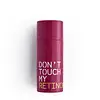What's inside
What's inside
 Key Ingredients
Key Ingredients

 Benefits
Benefits

 Concerns
Concerns

 Ingredients Side-by-side
Ingredients Side-by-side

Water
Skin ConditioningGlycerin
HumectantPropanediol
SolventPentylene Glycol
Skin ConditioningButylene Glycol
HumectantCyclohexasiloxane
EmollientCaprylyl Methicone
Skin ConditioningArtemisia Vulgaris Extract
Skin ConditioningDiglycerin
HumectantPentaerythrityl Tetraethylhexanoate
EmollientHydroxyethyl Acrylate/Sodium Acryloyldimethyl Taurate Copolymer
Emulsion StabilisingVinyldimethicone
Panthenol
Skin ConditioningSilica
AbrasiveChlorella Vulgaris Extract
Skin ConditioningGlucose
HumectantCarbomer
Emulsion StabilisingHydroxyacetophenone
AntioxidantDimethiconol
EmollientFructooligosaccharides
HumectantFructose
HumectantTromethamine
BufferingAcrylates/C10-30 Alkyl Acrylate Crosspolymer
Emulsion StabilisingGlyceryl Acrylate/Acrylic Acid Copolymer
HumectantLactobionic Acid
BufferingXanthan Gum
Emulsifying1,2-Hexanediol
Skin ConditioningArtemisia Princeps Leaf Extract
Skin ConditioningEthylhexylglycerin
Skin ConditioningAllantoin
Skin ConditioningDipotassium Glycyrrhizate
HumectantSodium Citrate
BufferingSodium Phytate
Xylitol
HumectantDextrin
AbsorbentTheobroma Cacao Seed Extract
AntioxidantMadecassoside
AntioxidantSalvia Officinalis Oil
MaskingAsiaticoside
AntioxidantCentella Asiatica Leaf Extract
Skin ConditioningTocopherol
AntioxidantWater, Glycerin, Propanediol, Pentylene Glycol, Butylene Glycol, Cyclohexasiloxane, Caprylyl Methicone, Artemisia Vulgaris Extract, Diglycerin, Pentaerythrityl Tetraethylhexanoate, Hydroxyethyl Acrylate/Sodium Acryloyldimethyl Taurate Copolymer, Vinyldimethicone, Panthenol, Silica, Chlorella Vulgaris Extract, Glucose, Carbomer, Hydroxyacetophenone, Dimethiconol, Fructooligosaccharides, Fructose, Tromethamine, Acrylates/C10-30 Alkyl Acrylate Crosspolymer, Glyceryl Acrylate/Acrylic Acid Copolymer, Lactobionic Acid, Xanthan Gum, 1,2-Hexanediol, Artemisia Princeps Leaf Extract, Ethylhexylglycerin, Allantoin, Dipotassium Glycyrrhizate, Sodium Citrate, Sodium Phytate, Xylitol, Dextrin, Theobroma Cacao Seed Extract, Madecassoside, Salvia Officinalis Oil, Asiaticoside, Centella Asiatica Leaf Extract, Tocopherol
Water
Skin ConditioningNiacinamide
SmoothingGlycerin
HumectantCetearyl Alcohol
EmollientC12-13 Alkyl Lactate
EmollientDimethicone
EmollientCaprylic Acid
CleansingCaprylic/Capric Triglyceride
MaskingPhospholipids
Skin ConditioningRetinol
Skin ConditioningC5-8 Alkyl Acrylate
Cetearyl Glucoside
EmulsifyingLactic Acid
BufferingSodium PCA
HumectantSodium Lactate
BufferingArginine
MaskingAspartic Acid
MaskingPCA
HumectantGlycine
BufferingAlanine
MaskingSerine
MaskingValine
MaskingProline
Skin ConditioningThreonine
Isoleucine
Skin ConditioningHistidine
HumectantPhenylalanine
MaskingPhenoxyethanol
PreservativeMethylparaben
PreservativeEthylparaben
PreservativePropylparaben
PreservativeAmmonium Acryloyldimethyltaurate Crosspolymer
Emulsion StabilisingVp/Va Copolymer
Tocopherol
AntioxidantHydrogenated Lecithin
EmulsifyingWater, Niacinamide, Glycerin, Cetearyl Alcohol, C12-13 Alkyl Lactate, Dimethicone, Caprylic Acid, Caprylic/Capric Triglyceride, Phospholipids, Retinol, C5-8 Alkyl Acrylate, Cetearyl Glucoside, Lactic Acid, Sodium PCA, Sodium Lactate, Arginine, Aspartic Acid, PCA, Glycine, Alanine, Serine, Valine, Proline, Threonine, Isoleucine, Histidine, Phenylalanine, Phenoxyethanol, Methylparaben, Ethylparaben, Propylparaben, Ammonium Acryloyldimethyltaurate Crosspolymer, Vp/Va Copolymer, Tocopherol, Hydrogenated Lecithin
 Reviews
Reviews

Ingredients Explained
These ingredients are found in both products.
Ingredients higher up in an ingredient list are typically present in a larger amount.
Glycerin is already naturally found in your skin. It helps moisturize and protect your skin.
A study from 2016 found glycerin to be more effective as a humectant than AHAs and hyaluronic acid.
As a humectant, it helps the skin stay hydrated by pulling moisture to your skin. The low molecular weight of glycerin allows it to pull moisture into the deeper layers of your skin.
Hydrated skin improves your skin barrier; Your skin barrier helps protect against irritants and bacteria.
Glycerin has also been found to have antimicrobial and antiviral properties. Due to these properties, glycerin is often used in wound and burn treatments.
In cosmetics, glycerin is usually derived from plants such as soybean or palm. However, it can also be sourced from animals, such as tallow or animal fat.
This ingredient is organic, colorless, odorless, and non-toxic.
Glycerin is the name for this ingredient in American English. British English uses Glycerol/Glycerine.
Learn more about GlycerinTocopherol (also known as Vitamin E) is a common antioxidant used to help protect the skin from free-radicals and strengthen the skin barrier. It's also fat soluble - this means our skin is great at absorbing it.
Vitamin E also helps keep your natural skin lipids healthy. Your lipid skin barrier naturally consists of lipids, ceramides, and fatty acids. Vitamin E offers extra protection for your skin’s lipid barrier, keeping your skin healthy and nourished.
Another benefit is a bit of UV protection. Vitamin E helps reduce the damage caused by UVB rays. (It should not replace your sunscreen). Combining it with Vitamin C can decrease sunburned cells and hyperpigmentation after UV exposure.
You might have noticed Vitamin E + C often paired together. This is because it is great at stabilizing Vitamin C. Using the two together helps increase the effectiveness of both ingredients.
There are often claims that Vitamin E can reduce/prevent scarring, but these claims haven't been confirmed by scientific research.
Learn more about TocopherolWater. It's the most common cosmetic ingredient of all. You'll usually see it at the top of ingredient lists, meaning that it makes up the largest part of the product.
So why is it so popular? Water most often acts as a solvent - this means that it helps dissolve other ingredients into the formulation.
You'll also recognize water as that liquid we all need to stay alive. If you see this, drink a glass of water. Stay hydrated!
Learn more about Water